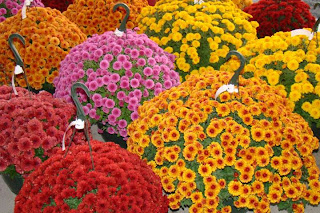As
the sizzle of the summer slowly leaves us for the fair-weathered temperatures
of fall, we enjoy being outdoors more, but don’t always know what to do with
our energies. Many ask if it is
too late to accomplish their fertile dreams of summer. The following Chinese Proverb is my
answer to that question. “The best
time to plant a tree was twenty years ago. The second best time is now”.
Fall is also the best time to select trees and
shrubs for that brilliant color.
It is surprising that trees vary in color, even those labeled with the
same name. Look for the brightest
color in a block of similar trees.
Now is the time for planting many types of
trees. The cooler, moister weather
of fall makes for less stressful conditions and lessens your chances of root
loss.
Contrary to popular belief, fall is also the
perfect time for adding many other plants to your garden.
Yes, I know how tempting it is to go crazy with
new plantings come spring, but you can get a head start by planting many
specimens now. A plant set out now
has summer’s peak heat behind it, the probability of soaking rains ahead and
still warm soil to encourage immediate and deep root growth.
Water-wise gardeners have long recognized the
value of fall planting. As days
shorten and nights lengthen, plants transpire less and require less water. Strong roots begin to develop in the
warm soil, and soaking winter rains encourage them to penetrate deeper.
 For an instant garden and a blast of color as
summer turns into fall, fill your flowerbeds and empty spaces in your landscape
with chrysanthemums. They come in
a wide range of autumn colors from white, yellow, and gold to bronze and
maroon. Lighter colors tend to
bloom earlier than the darker reds and purples, so select different colors for
a longer display of color.
For an instant garden and a blast of color as
summer turns into fall, fill your flowerbeds and empty spaces in your landscape
with chrysanthemums. They come in
a wide range of autumn colors from white, yellow, and gold to bronze and
maroon. Lighter colors tend to
bloom earlier than the darker reds and purples, so select different colors for
a longer display of color.
What’s nice about mums, in addition to the long
bloom time, is that they can be transplanted while in full bloom. Just be sure to water thoroughly until
they become established.
Mums also work well as container plants to
decorate patios, porches, and decks. Go easy on the water, however, to prevent
root rot. Potted mums probably
will not do well inside as lower light levels often result in yellowing leaves
and droopy flowers.
Flowering kale and cabbage also make nice fall
plants to replace annual flowers.
Both will turn a beautiful color with the cold and will last until
covered with snow. Or try fall asters,
which are grown in pots by many garden centers for sale at this time of
year. They provide good color, and
many are hardy as well.
Think Spring
If you are hoping for flowers that spring up in
the spring, you’d better fall back on some good gardening techniques. Most importantly, dividing old
perennials, planting spring flowering bulbs and repotting houseplants.
September is a good time to plant
perennials. The winter rest will
allow the plants to develop strong root systems that will allow them to better
withstand the heat of summer.
Plant bulbs in the fall, starting when nighttime
temperatures stay between 40-50°F.
But, be sure to plant approximately six weeks before the ground freezes
to allow sufficient time for rooting.
Bulbs will root best in cool soil and once rooted, undergo natural
changes that keep them from freezing.
Water your bulbs after planting to help them start the rooting process.
Before you move your houseplants back inside,
repot any that have become root bound and check them all carefully for insect
pests or their eggs. Spray with
insecticidal soap. Clear out your
windowsills to allow as much light as possible to come in to keep your plants
healthy. Houseplants should be
brought indoors before night temperatures drop below 50°. Planting pots that will be stored away
for winter should be washed in a solution of one part bleach and ten parts
water to ward off fungus and disease next spring.
You can pot up some herbs to take indoors for
winter use. Since many culinary
herbs lose much of their flavor when dried, why not freeze then instead! Pick the foliage, toss in a baggie,
label, and store in the freezer until needed.
Tom
McNutt is a professor emeritus at The Ohio State University and a retired TV
garden expert.
